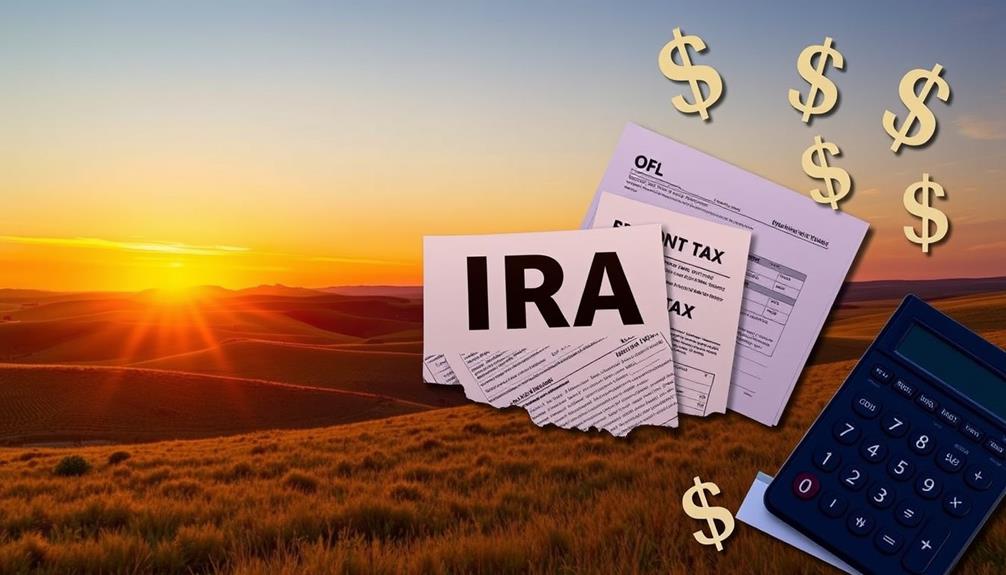When you take out money from your IRA in Oklahoma, it is considered taxable income. Fortunately, if you are 65 or older, you can deduct up to $10,000 of your retirement income, which includes IRA withdrawals. This means only the amount above that deduction is taxed at state income tax rates ranging from 0.5% to 5%. To take advantage of this deduction, you will need to submit Schedule 511-A. It is important to carefully plan your withdrawals to minimize unnecessary taxes. Keep researching how these regulations affect your scenario for successful retirement planning.
Key Takeaways
- IRA withdrawals in Oklahoma are subject to state income tax and can be taxed at rates from 0.5% to 5%.
- Seniors aged 65 and older can claim a $10,000 retirement income deduction on IRA withdrawals to reduce taxable income.
- Filing Schedule 511-A is necessary to take advantage of the retirement income deduction for IRA withdrawals.
- Excess retirement income beyond the $10,000 deduction will incur state income tax, so effective planning is crucial.
- Consulting a financial advisor can help retirees optimize their IRA withdrawal strategy and minimize taxes in Oklahoma.
Overview of Oklahoma Tax Policies

When it comes to retirement planning, understanding Oklahoma's tax policies can greatly impact your financial well-being. One major advantage for retirees is that Oklahoma exempts Social Security retirement benefits from state income tax. This exemption can markedly boost your retirement income.
If you're a senior aged 65 or older, you can also claim a $10,000 retirement income deduction on various income sources, including distributions from IRAs and 401(k) plans.
However, keep in mind that any retirement income exceeding this deduction is subject to Oklahoma income tax rates, which range from 0.5% to 5%. To benefit from the retirement income deduction, you'll need to file Schedule 511-A with your state income tax return.
Additionally, Oklahoma's property taxes are relatively low, with a median payment around $1,349. This provides further financial relief for retirees, allowing you to stretch your retirement savings further.
Tax Treatment of IRA Withdrawals

How do IRA withdrawals impact your taxes in Oklahoma? In Oklahoma, IRA withdrawals are treated as taxable income and fall under state income tax rates ranging from 0.5% to 5%, depending on your income level.
Unlike Social Security benefits, which are fully exempt from state income tax, all taxable IRA distributions will be taxed.
If you're 65 or older, you can claim a retirement income deduction of up to $10,000 on your IRA withdrawals. This deduction can help lower your taxable income, making it significant for effective tax planning.
To take advantage of this deduction, you'll need to file Schedule 511-A with your state tax return.
It's important to understand that while IRA withdrawals are considered retirement income taxable in Oklahoma, they aren't the only source of retirement income you might have.
Proper tax planning becomes critical when you have multiple sources of retirement income, ensuring you maximize deductions and minimize your overall tax liability.
Deductions for Retirement Income

If you're a senior in Oklahoma, you can take advantage of a $10,000 deduction on your retirement income, including IRA withdrawals.
Plus, Social Security benefits won't be taxed at all, giving you even more financial breathing room.
Understanding these deductions can greatly reduce your taxable income, making retirement a bit easier.
Social Security Exemption Details
Oklahoma offers retirees valuable tax benefits, including a full exemption for Social Security retirement benefits from state income tax. This means that if you rely on Social Security as a significant part of your retirement income, you won't have to worry about it affecting your taxable income in Oklahoma.
In addition to this exemption, retirees aged 65 and older can claim a $10,000 deduction on other forms of retirement income, such as pensions and 401(k) distributions. If your retirement income exceeds this exemption, you'll need to file Schedule 511-A to claim any deductions. This process guarantees you maximize your savings and minimize your state income tax burden.
With Oklahoma's state income tax rates ranging from 0.5% to 5%, these exemptions and deductions create a favorable tax environment for retirees.
By combining the Social Security exemption with the retirement income deduction, Oklahoma stands out as one of the more tax-friendly states for retirees.
Retirement Income Deduction Benefits
Retirees in Oklahoma can greatly benefit from the state's retirement income deduction, which allows those aged 65 and older to deduct up to $10,000 from their taxable retirement income. This deduction applies to various sources of retirement income, including IRA withdrawals and 401(k) distributions.
Additionally, Social Security retirement benefits are fully exempt from state income tax, providing further financial relief.
If your retirement income exceeds the $10,000 deduction, the excess will be subject to Oklahoma's state income tax rates, which range from 0.5% to 5%. To maximize your tax savings, make sure to file Schedule 511-A. This form enables you to claim the retirement income deduction correctly, ensuring you optimize your taxable income.
The combination of low property taxes and the retirement income deduction makes Oklahoma an attractive option for many retirees. By taking advantage of these benefits, you can stretch your retirement savings further and enjoy your golden years with greater financial security.
Impacts of Sales and Property Taxes

When you think about living in Oklahoma, it's important to evaluate how sales and property taxes may affect your budget.
While the state has a reasonable sales tax that includes groceries, property tax rates remain low, especially for retirees who might qualify for homestead exemptions.
Keep in mind that local governments can vary these rates, adding another layer to your financial planning.
Sales Tax Overview
Maneuvering the sales and property tax landscape in Oklahoma can feel overwhelming, especially for those on fixed incomes. Here are three key points to reflect on:
- Oklahoma's statewide sales tax rate is 4.5%, but local jurisdictions can increase this, leading to an average combined sales tax rate of about 7%.
- Unlike many states, sales taxes apply to groceries, although low-income tax credits can help ease the burden on lower-income residents.
- While property taxes are relatively low, with a median property tax payment around $1,349 and an effective property tax rate of 0.89%, variability exists due to local government decisions.
For retirees, the combination of low property taxes and available Homestead exemptions provides essential property tax relief.
These exemptions can greatly lessen the financial impact on qualifying seniors. Additionally, since property taxes in Oklahoma don't typically impose a severe burden, retirees can find some comfort in this aspect of their financial planning.
Understanding these sales and property tax dynamics is critical for managing your budget effectively, especially when relying on fixed incomes or IRA withdrawals.
Property Tax Advantages
Property taxes in Oklahoma offer considerable advantages, especially for seniors looking to stretch their retirement income. With a median payment around $1,349 and an average effective property tax rate of just 0.89%, Oklahoma's property tax landscape is quite affordable for retirees. You can benefit from homestead exemptions if you qualify, considerably reducing your property tax burden.
While the statewide sales tax rate stands at 4.5%, local property tax rates can push this up to roughly 7%, affecting overall living expenses, including groceries. However, low-income tax credits are available, helping offset these sales tax costs and providing additional financial relief to eligible residents.
When considering your retirement options, it's vital to evaluate specific areas within Oklahoma, as local property tax rates can vary. This variability allows you to find locations that maximize your tax advantages.
Local Tax Variability
Tax variability across Oklahoma creates a complex landscape for retirees maneuvering their financial futures. Understanding the nuances of common financial terms can aid in making informed decisions about withdrawals and budgeting. Here are three key points to reflect upon:
- Property Tax Rates: Local governments set property tax rates, leading to variability across the state, but overall, property taxes remain manageable for retirees.
- Sales Tax Impact: The statewide sales tax is 4.5%, but local increases can push it to around 7%, affecting your everyday expenses.
- Groceries Taxed: Unlike many states, Oklahoma applies sales tax to groceries, although low-income tax credits can ease this burden for retirees.
When you're planning your retirement income and reflecting on IRA withdrawals, local tax variability can influence your overall financial picture.
While Oklahoma's property taxes are lower than the national average—averaging around $1,349 annually—higher sales taxes can impact your cost of living.
Thankfully, with property taxes not greatly burdening retirees, you might find some financial relief.
Balancing these state taxes and understanding how local tax variability affects your situation will help you make informed decisions as you navigate your retirement years in Oklahoma.
Investment Income Tax Considerations

Understanding how your investment income is taxed in Oklahoma can greatly impact your financial planning, especially during retirement.
When you make IRA withdrawals, it's crucial to be aware that these distributions are subject to state income tax. If you're 65 or older, you can claim a $10,000 deduction on your retirement income, which includes IRA withdrawals. This deduction can considerably reduce your taxable income, but any amount exceeding the $10,000 threshold will be taxed at rates ranging from 0.5% to 5%.
Oklahoma doesn't provide specific tax breaks for investment income, meaning interest and dividends are also subject to state income tax. Additionally, capital gains from IRA withdrawals are taxed at the same rates as regular income. This makes tax planning important for optimizing your returns and minimizing your overall tax burden.
To take full advantage of available deductions, retirees should file Schedule 511-A when submitting their tax returns.
Understanding these key aspects of retirement income and state income tax in Oklahoma can help you make informed decisions that can positively affect your financial future.
Strategies for Effective Retirement Planning

Effective retirement planning hinges on strategic decision-making, particularly when it comes to your IRA withdrawals. In Oklahoma, understanding how to optimize your retirement income while minimizing state income tax can save you money.
Here are three essential strategies to take into account:
- Maximize Deductions: Take advantage of the $10,000 state income tax deduction for seniors aged 65 and older. This can considerably reduce your taxable income from IRA withdrawals.
- Timing is Key: Plan your IRA withdrawals carefully. By timing them to avoid exceeding the $10,000 deduction threshold, you can minimize your overall tax liability.
- Consult Financial Advisors: Work with financial advisors who understand Oklahoma's tax landscape. They can help you develop personalized strategies for IRA withdrawals, ensuring you maximize deductions and minimize taxes.
Staying informed about potential changes in state tax laws is vital, as these can impact your retirement planning.
By applying these strategies, you'll enhance your retirement income while effectively managing your tax exposure in Oklahoma.
Don't leave money on the table—be proactive in your approach to IRA withdrawals and retirement planning.
Frequently Asked Questions
Do You Pay State Income Tax on IRA Withdrawals?
Yes, you do pay state income tax on IRA withdrawals. The amount you owe depends on your total income and applicable tax rates, so it's essential to plan your withdrawals wisely to minimize taxes.
What Is the Retirement Tax Exclusion in Oklahoma?
In Oklahoma, you can deduct up to $10,000 from your retirement income if you're 65 or older. This deduction includes IRA withdrawals, helping you reduce your state tax burden and keep more of your money.
What Is the Retirement Exclusion for Oklahoma in 2024?
In 2024, you can claim a $10,000 retirement income deduction in Oklahoma, which includes various sources like IRA withdrawals. Make sure to file Schedule 511-A to benefit from this tax exclusion effectively.
Do You Pay State Taxes on 401K Withdrawals?
Imagine a garden where every flower represents your hard-earned savings. When you pick a 401(k) bloom, you'll find that state taxes can nibble at your harvest, depending on where you plant your roots.
Conclusion
In traversing Oklahoma's tax landscape, understanding the implications of your IRA withdrawals is essential. Think of it as steering through a winding road; knowing the bumps and turns can help you avoid costly mistakes. By staying informed about tax treatments, deductions, and other factors, you can plan effectively for a comfortable retirement. With the right strategies in place, you can guarantee your hard-earned savings work for you rather than against you.









